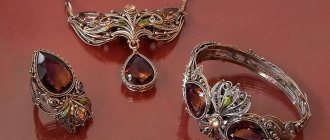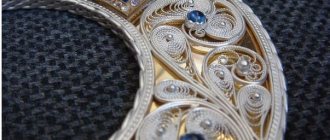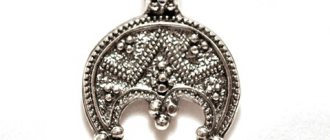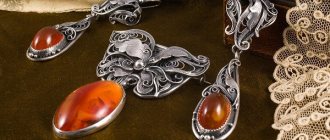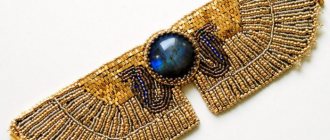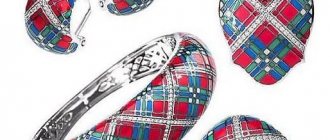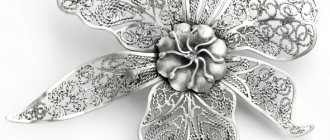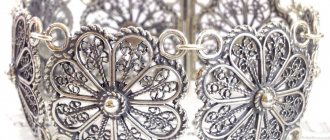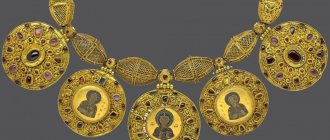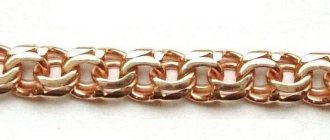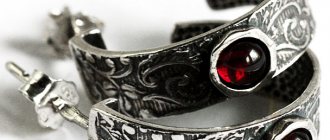This jewelry technique has come down to the present day from time immemorial with minimal changes. Even today, artisans use the same filigree or filigree to create jewelry as their predecessors did many centuries ago. So what is filigree and what is filigree? We understand the concepts and evaluate the works of modern Russian masters.
What is scan
The art of scanning has been known since the second century AD. Over more than 900 years of history, filigree has only become more complex: the blind technique was transformed into openwork, and even refractory steel began to be used instead of soft precious metals.
In Ancient Rus', the first mentions of filigree art appeared in the 9th century. The openwork filigree technique was not yet used at that time, preferring granulation to it, that is, soldering metal balls to jewelry or any other sets and inventing their intricate patterns.
Openwork lace, which is a composition of patterns made of metal wires without a background, has been used since the 12th century. At the same time, jewelers began to complicate the technique, decorating filigree items with precious stones and enamel.
Filigree in ancient Rus'
The art of soldering openwork lace from the finest wire and forming translucent products is called filigree or filigree. Russian craftsmen inked jewelry and tableware, but in the 9th century they learned to cover the jewelry with the finest wire, forming intricate patterns. The development of filigree was influenced by trade; from Europe and Asia, merchants brought jewelry and household items using similar techniques; our craftsmen learned to twist woven material so finely. That they soldered unique patterns.
The growing demand for increasingly complex designs stimulated craftsmen to improve their skills. Buttons preserved from the 16th century, decorated with the finest metal mesh made using the filigree technique, are still of great interest to us today. It was believed that the thinner and more complex the pattern, the nobler and more unique the object.
The heyday of filigree painting occurred between the 18th and 19th centuries. At that time, it was considered as a type of jewelry art and was used not only for making jewelry, but also for painting small objects. All filigree items, whether voluminous panels or just small cigar boxes, were made by hand, although the demand for filigree was very high.
Modern Kazakovsky filigree and price for 2022
Filigree is an art that was hardly damaged during the Soviet era. This was mainly due to the fact that filigree was recognized as a national treasure and a folk historical craft. This allowed her to continue to develop, albeit at a different pace.
Filigree - historical background
It is believed that the first masters to master this interesting technique were people from Ancient Egypt and Ancient Greece. The oldest specimens discovered during excavations in ancient cities date back to the 6th century BC.
European masters created unique jewelry for the wealthy bourgeoisie and nobility. The 19th century is rightfully considered the peak of filigree craftsmanship. At this time, jewelry was mass produced and was available to almost all social classes.
Russian filigree originates in ancient times. In Ancient Rus', filigree was primarily ceremonial objects, which then migrated to the caskets of princesses.
Krasnoselskaya filigree (Kostroma)
At an exhibition in Paris in 1937, the famous “Krasnoselskaya filigree” created a world sensation. This success was repeated two years later in New York.
Karl Bohlin and Gottlieb Jan
Ladle. Silver, enamel. 1908–1917. Photo: qna.center
Caviar. Silver, crystal. Casting, chasing, engraving, gilding, diamond cutting. 1908–1917. Photo: qna.center
Box in the shape of a butterfly. Silver, diamonds, pearl, enamel. 1898–1908. Photo: qna.center
Petersburgskaya made precious jewelry and gifts for the royal family and courtiers. The company was founded by Karl Bohlin and Gottlieb Jan, two sons-in-law of the famous Saxon master Andreas Rempler, who served at the court of Paul I.
worked under six Russian monarchs and carried out orders from the imperial palace for more than a century. The Review of the London World's Exhibition of 1851 said that Bohlin's work "decidedly surpassed in perfection of setting everything that was in the exhibition, not even excluding the diadem of the Spanish Queen by the famous Parisian jeweler Lemonnier." In 1912, Nicholas II granted the family hereditary nobility. Today, the jewelers’ works are stored in the Diamond Fund and have the status of crown treasures.
Variety of filigree work
There are many ways to add variety to the filigree technique: using enamel and gemstones, using wire patterns on niello, or a combination of filigree techniques.
There are a total of 3 main types of this jewelry art:
Soldered filigree
It is a jewelry making technique in which a wire pattern is soldered onto a sheet of metal. It is quite often combined with enamel and differs in the type of background (faded) filigree, chased (bordered) filigree, cloisonné enamel, etc.
Openwork filigree
The openwork technique involves connecting wire parts without soldering them to any substrate. Making metal lace requires a lot of experience in working with metals and careful soldering. An addition to this technique are metal balls soldered to the lace elements.
Volumetric filigree
To make voluminous filigree jewelry, a step-by-step method is used: several elements made in openwork filigree are combined into one composition.
filigree and enamel in one decoration
Using the technique of filigree from precious metals, you can create colorful combinations with various materials: precious and semi-precious stones, enamel , unglazed silver, glass and wood.
The variety of inlays in filigree jewelry required great skill in working with metals. For example, to complete a niello ornament, it was necessary to sprinkle the product with an alloy of several metals and fire it so that the molten niello filled the relief pattern.
Initially, filigree masters chose only precious metals such as gold and silver, preferring the former due to a number of its qualities:
- Firstly, gold is a very fusible metal, i.e. heating it to a “sticky” state requires a temperature much lower than the melting point of steel or iron.
- Gold is an extremely ductile material. With high purity, it is easily deformed even without heating.
- Gold is a fairly economical material. This means that from a relatively small amount of this metal it is possible to pull out an impressive length of gold wire consisting of disparate patterns: rings, arcs and vortices.
Gold Filigree Spoon and Cup and Saucer
This precious metal has been highly valued throughout human history. The richest members of society decorated themselves with gold objects, the manufacturing techniques of which became more and more complex over time. Gold ornaments of Russian filigree decorated cases for icons, basmas and earrings.
Coinage
Embossing is one of the types of cold metal processing. With the help of coinage, a wide variety of artistic works were created and are being created. By embossing you can make thin miniatures for jewelry, various relief ornamental compositions, apply various decorative textures, and use deep punches to mint large monumental works. Embossing is now widespread in the manufacture of various decorative art products from copper, aluminum, brass, black decapir and other materials.
Kanfarnik: a - round, 6 - octagonal
Embossing on sheet metal is the most difficult of all types of artistic embossing, since when working on sheet metal, you need to create a pattern, relief, and texture of the material in the process of work, and when chasing by casting, only the identification and completion of a previously created form, cast from various metals.
The minting process involves processing metal using a special set of mints, different in shape and purpose, and a hammer. During the minting process, auxiliary materials and devices are also used. The coins are specially forged steel rods 120 mm long. In short, they are inconvenient because they do not allow you to strike freely without injuring your hands. For special works, the coins may be longer.
Contour embossing is embossing on the plane of sheet metal without punching out the relief. In other words, this is the creation of a contour pattern on a metal plane using a consumable, a purulent and textured embossing. This technique is somewhat reminiscent of engraving, but with the embossing technique it is easier to create a more lively and juicy design, accentuating it in places with stronger blows and the use of some other embossing, in addition to the consumables.
Contour embossing can be made either concave, lowered down, or convex, raised above
Contour embossing with background elaboration and the use of textured embossing
line background. This type of coinage was very often used to create various household items, which were decorated with floral and other types of ornaments, made in one line without punching out the relief. In the V and IV centuries. BC e. The Scythians left many different samples of precious metals, including contour coinage using different textures both in the background and in the depicted pattern. Interesting are the metal works of art from the Sassanid era, which depict the struggle of various animals, fish, and vegetation. The outline of the drawing is clearly marked, the background is clear, and the entire image is embossed with different textures and strokes that enhance the character of the subject.
A type of contour embossing is convex contour embossing , where the design is readable due to a convex line that is raised by a consumable on the reverse side.
Contour chasing under enamel. This method of minting has some features when creating partitions for enamel. As is known, in the past and now there are cloisonne hot enamels. In this case, partitions made of metal strips or rolled wire were soldered, and then enamel was applied. You can make these partitions by embossing a special consumable on the reverse side of the product. To emboss partitions, you should take a consumable, the working part of which should have a soft roundness of small thickness. The embossing is done on hard resin so that the partition is clearer and less likely to “drag” the background behind it. Creating a partition by embossing is advisable when fine modeling of the pattern is not required. Creating partitions under enamel using the embossing method is distinguished by decorativeness, richness and lightness of the design.
Silver candy bowl (second half of the 18th century)
Openwork embossing differs from contour embossing in that the background of the ornament or other image is carved using special cuts.
Relief coinage is the most common type of coinage, both in the past and today. There are many examples in Russian decorative art of relief embossing with complete processing of the relief of varying heights and degrees of detail. Depending on the size of the product and the height of the relief, one or another minting method is used. Embossed relief can be created by lowering the background, but only at a small height, up to about 3 mm. Reliefs of greater height are obtained by various methods of punching. Reliefs can be very finely and carefully worked out with the application of different textures or made only with a punch with some
Decorative and textured embossing. Modern work
coinage.
Decorative and textured embossing. This type of coinage has become especially widespread these days (Fig.). However, there are many examples of textured embossing in the past. For example, products from the collection of Scythian gold. The golden bowls were decorated with diamond-shaped spikes all over the surface. The brothers of the 17th century were also equipped with similar decorations. Textured coinage is very skillfully used in Georgian coinage.
Embossing by casting
Casting embossing is used only when the product is cast into an earthen mold. Artistic casting in an earthen mold is always inferior in clarity to the surface of the model on which it was cast. To ensure that the surface of the casting does not differ from the surface of the model, it is necessary to restore the lost parts.
For casting embossing, the same tools and devices are used as for sheet embossing. The only difference is that for minting castings, a smaller number of mints is required, since here only the outer surface of the product is minted. However, coins for casting must have greater hardness.
Filigree in mass production
In the 17th century, the demand for embossed jewelry increased, and serious jewelry in the Scanción style appeared, in which, in addition to stones, crystals and mother-of-pearl were used. The craftsmen also did not forget about making various household items: vases, salt shakers and boxes. Since the 19th century, filigree has become a manufactured product. Technologies improved, openwork filigree flourished, and translucent stained glass windows appeared - openwork filigree with transparent enamel.
After a decline at the beginning of the 20th century, the filigree technique regained its strength beginning in the middle of the century. In 1937, the works of craftsmen from the village of Krasnoe-on-Volga (“Krasnoselsky craftsman”, near Kostroma) were shown at the World Exhibition in Paris, where they accepted gold for filigree brooches, boxes and other accessories, and in 1939 in New York .
Olovyanishnikov Dynasty
Bells for Bulgaria. 1877. Photo: wikimedia.org
Bowl for storing prosphora. XIX century Photo: modusvivendi.ru
Church utensils. XIX century Photo: wikimedia.org
For two centuries, the Olovyanishnikov jewelry dynasty cast entire “bell families” and valuable church utensils. Representatives of the creative dynasty cast the first bells in the first half of the 18th century. Three brothers - Fyodor, Porfiry and Kliment Olovyanishnikov - became merchants of the third guild and ran a common business. To cast the bells, they invited the best acoustician of their time, the inventor of the bell tuning fork, Aristarchus of Israel. The “Russian style” of the Olovyanishnikovs’ church utensils is the merit of the artist Sergei Vashnikov, Viktor Vasnetsov’s favorite student. The bells, caskets, and miters of the Olovyanishnikovs “toured” all over the world. They exhibited in Paris, New Orleans, and Chicago. The craftsmen were also valued in their homeland: “In recognition of exceptional services to Russia,” the plant received the right to depict the imperial coat of arms on its products.
Modern brand Kazakovskaya filigree
Kazakovskaya filigree (photo from the main website of the plant)
Today Kazakova’s Art Products (KAZAKOVKA) (KPHI) is a serious “filigree” brand, specializing primarily in products using this technique. KPHI brand jewelry is usually made of silver plated alloy.
What are the specifics of Kazakh filigree? When creating a pattern, the master pays attention to the harmony of its individual parts, the beauty of the lines of the largest and thinnest elements. The artist works on the design of the slots, which is very important when creating patterns. The charm of Cossack products lies in their openness - appreciate the beauty of the work in the photo.
Filigree 'Kubachi'
Kubachi jewelers (kubachi.su), along with the techniques of blackening, stamping and engraving traditionally known in Dagestan, also produce filigree jewelry of extraordinary beauty.
Russian masterpieces
Filigree (along with graining) has become one of the most famous jewelry making techniques in Russia. Workshops for the production of jewelry and exquisite utilitarian items were located at princely courts and monasteries. Over the course of many centuries, Russian jewelers improved this technology.
In the 18th and 19th centuries, there were several factories producing filigree items. Original filigree artwork includes rings, wedding rings, brooches, pendants, amulets and rattles. Even binoculars and lighters were decorated in this technique, which was part of the Art Nouveau style.
Carl Faberge
Faberge Egg “Basket of Flowers”. 1901. Photo: happymodern.ru
Golden basket with lilies of the valley. 1901. Photo: lermontovgallery.ru
Faberge Egg "Bay Tree". 1911. Photo: happymodern.ru
Hereditary jeweler Carl Faberge was raised in classical traditions. He combined elements of sculpture, painting and graphics in his precious products, and also tried to revive in them the emotions and memories of his crowned customers. An example of such synthesis is Easter eggs. They were created by a huge creative team of 600 craftsmen from all over the world. The tradition of giving each other precious gifts for Easter appeared in the imperial family in the second half of the 19th century. Alexander III ordered the first egg for Empress Maria Feodorovna, Nicholas II gave precious gifts to both his mother and his wife Alexandra Feodorovna every spring. After one of the exhibitions of Carl Faberge, Alexander III noted that his works should be kept in the Hermitage as an example of the skill of Russian jewelers.
Forge or pull
Jewelry masterpieces created using filigree techniques existed before our era. The difference from ancient Russian filigree is determined by the method of making wire from precious metals or alloys. The wire was forged or the workpiece was pulled through a drawing device, resulting in a thin jewelry thread. In Ancient Egypt and Greece, forging was used to make it.
14th century gold filigree boxes
Old Russian masters, starting from the 10th century, made filigree silver and gold carvings using the second method - according to a drawing. The best way to see what was made from skaj centuries ago is to visit museums. There are excellent examples of princely household items and church vessels, decorated with fabulous ornaments. Clothing (shoes, belts, etc.), book covers, dishes, crosses - filigree patterns flourished everywhere. It is worth recalling that Monomakh's hat is decorated with filigree.
Pavel Ovchinnikov
Salt shaker with enamel. Russian Empire, Moscow. 1899–1908. Photo: lermontovgallery.ru
Beer mug "Peasants returning from haymaking." Russian Empire, Moscow. 1873. Photo: lermontovgallery.ru
Ladle. Russian Empire, Moscow. 1899–1908. Photo: lermontovgallery.ru
The famous manufacturer and goldsmith was a serf of Prince Dmitry Volkonsky. He was fond of drawing, and the talented boy was sent to Moscow to develop his abilities. In 1850, Pavel Ovchinnikov received his freedom, got married, and started his own business with his wife’s dowry.
How is filigree jewelry made?
The elements of a filigree pattern are rope, cord, weaving, herringbone, track, satin stitch, and so on. It is essentially a lace appliqué made from metallic thread. Filigree is often combined with granulation - small balls that are soldered into prepared cells (recesses). Granulation gives filigree a particularly elegant, sophisticated look. Alloys of gold, silver and platinum, as well as copper, brass, nickel silver, and nickel silver are used as materials for the manufacture of products. All types of jewelry can be made using the filigree technique.
False scan
The methods reduce production costs by speeding up the process. False (cast) filigree and grain are products cast in prefabricated molds from slate and limestone. The pattern is not formed by the artist, but is poured into a form. These decorations are similar to the original filigree decorations, but differ in simpler, uncomplicated patterns without relief.
If you liked the article, share it on social networks, it’s important to us
Tags: features of jewelry technology since the times of ancient Rus', Filigree and filigree - what is it
